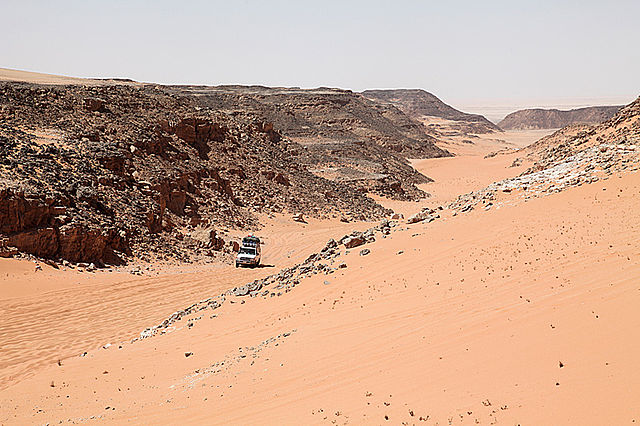Gilf Kebir
Plateau in Egypt and Libya From Wikipedia, the free encyclopedia
Plateau in Egypt and Libya From Wikipedia, the free encyclopedia
Gilf Kebir (جلف كبير) (var. Gilf al-Kebir, Jilf al Kabir, Gilf Kebir Plateau) is a plateau in the New Valley Governorate of the remote southwest corner of Egypt, and southeast Libya. Its name translates as "the Great Barrier". This 7,770 km2 (3,000 sq mi) sandstone plateau, roughly the size of Puerto Rico, rises 300 m (980 ft) from the Libyan Desert floor. It is the true heart of the Gilf Kebir National Park.
| Gilf Kebir | |
|---|---|
 View from the top of Gilf Kebir overlooking Wadi Sura | |
| Highest point | |
| Elevation | 1,014 to 1,016 m (3,327 to 3,333 ft) |
| Coordinates | 23°26′29″N 25°50′23″E |
| Geography | |
| Country | Egypt |
The name Gilf Kebir was given to the plateau by Prince Kamal el Dine Hussein in 1925, as it had no local name.[1] It is known for its rugged beauty, remoteness, geological interest, and the dramatic cliff paintings-pictographs and rock carvings-petroglyphs which depict an earlier era of abundant animal life and human habitation.
The Uweinat mountain range at the very south of the plateau extends from Egypt into Libya and Sudan.
The plateau is crisscrossed by Wadis (dry, seasonal riverbeds). These include:
Gilf Kebir Plateau lies in the heart of the eastern part of the vast Sahara Desert, and, thus, gets some of the most extreme climates on Earth. This is the driest place on the planet, not only because the area is totally rainless (the annual average rainfall amount hardly reaches 0.1 mm) but also because the geological aridity index/dryness ratio is over 200, which means that the solar energy received at the ground evaporates 200 times the amount of precipitation received.[2] Rainfall may fall every twenty years in Gilf Kebir.
| Climate data for Gilf Kebir Plateau | |||||||||||||
|---|---|---|---|---|---|---|---|---|---|---|---|---|---|
| Month | Jan | Feb | Mar | Apr | May | Jun | Jul | Aug | Sep | Oct | Nov | Dec | Year |
| Mean daily maximum °C (°F) | 20.8 (69.4) |
23.6 (74.5) |
27.8 (82.0) |
33.8 (92.8) |
36.6 (97.9) |
38.3 (100.9) |
38.7 (101.7) |
38.6 (101.5) |
37.2 (99.0) |
32.3 (90.1) |
26.3 (79.3) |
22.1 (71.8) |
31.3 (88.4) |
| Mean daily minimum °C (°F) | 7.7 (45.9) |
10 (50) |
12.4 (54.3) |
18.4 (65.1) |
22.2 (72.0) |
24.9 (76.8) |
26.1 (79.0) |
26.3 (79.3) |
24.2 (75.6) |
19.2 (66.6) |
13.2 (55.8) |
8.7 (47.7) |
17.8 (64.0) |
| Source: Storm247.com[3] | |||||||||||||

The Gilf Kebir is known for its prehistoric Neolithic petroglyphs
Saharan rock art has been found to resemble the art of Nile valleys. The Saharan area was wetter until mid-Holocene or about 4000 BC, when the monsoon retreated southwards, forcing humans to migrate. Some retreated eastward to the Nile valley, taking with them their beliefs and influencing Egyptian art.[4][5][6]

The hills of the Gilf Kebir were first seen from a distance by European explorers in 1910 - with W. J. Harding-King in 1910 and 1911, and Ball and Lieutenant Moore in 1918. The high southern part of the plateau was sighted for the first time by Prince Kamal el Dine Hussein in 1925, and on another expedition, in the following year, he fixed the eastern escarpment of the plateau and first realised the true size of the plateau. In 1930 an expedition headed by Ralph Alger Bagnold followed the same route. In the winter of 1930-1, P. A. Clayton surveyed some of the areas.
The western side of the Gilf Kebir was explored in 1932 by the Clayton-Almásy Expedition, headed by Sir Robert East Clayton and Count László E. Almásy, and accompanied by Patrick A. Clayton, Squadron Leader H. W. G. J. Penderel, three Arabian car drivers and a cook. The expedition explored the area by Gypsy Moth plane, by car, and on foot.
1933 Patrick Clayton and Ladislaus Almasy discovered the Aqaba-Pass, the only way up Gilf Kebir from the southern plains i.e. from wadi Sura.[7]
The plateau was the site for various British logistical operations during the Second World War, and due to the extremely dry conditions and lack of population, remains of this occupation are often found intact. A large airbase, including huge navigation arrows laid out in army petrol cans, can still be seen at the Eight Bells Hills spot in the southeast of Gilf Kebir.
It was also the site of the 2007 discovery of a bag that had been lost in the Second World War by a dispatch rider (Alec Ross) of the Long Range Desert Group, part of the British Army. This contained the rider's personal letters and photographs and had been well preserved.[8]
The Gilf Kebir is the setting for part of Michael Ondaatje's novel The English Patient. It also plays an important role in Paul Sussman's The Hidden Oasis.
Seamless Wikipedia browsing. On steroids.
Every time you click a link to Wikipedia, Wiktionary or Wikiquote in your browser's search results, it will show the modern Wikiwand interface.
Wikiwand extension is a five stars, simple, with minimum permission required to keep your browsing private, safe and transparent.